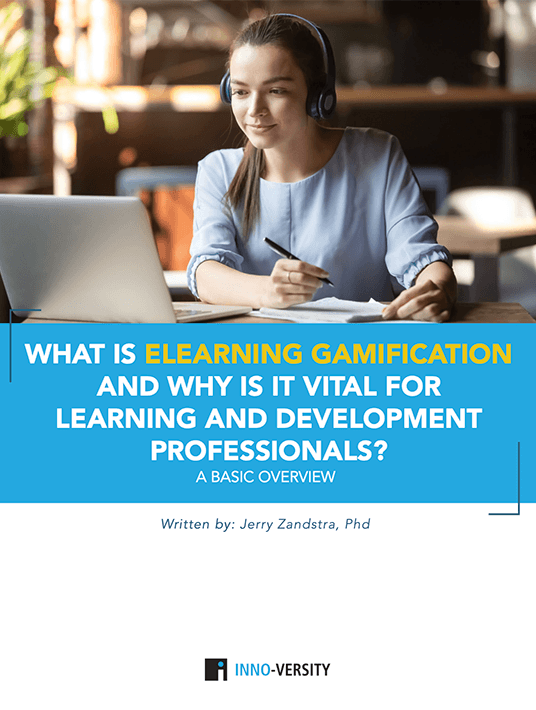eBook
What Is eLearning Gamification And Why Is It Vital For L&D Professionals?
by Inno-Versity / Published: Jun 16 2020
What it's about
Games engage, challenge, motivate, and entertain. Why click through slides when you can play and learn at the same time? Learn how to bring gamification to your learning with solid theory and great case studies.
Key chapters
-
What Is eLearning Gamification And Why Is It Vital?
In a learning environment, a game provides enjoyment, challenge, and opportunity. Gamification, when done well, entices, motivates, challenges, and empowers learners so they willingly achieve higher objectives. It is more than entertainment, although games need to be fun. Games lead to deeper engagement, and that brings better retention and changes in behavior. Learners explore concepts, make strategic decisions, receive immediate feedback, and willingly re-engage after unsuccessful attempts. -
Developing A Gamification Strategy
Motivation matters in learning. And this is part of the attraction of gamification. Games are inherently motivational. Very few board or card games are played by families or friends because it was deemed mandatory. Playing the game is its own reward. This chapter explores what motivates learners and how gamification can tap into that motivation. -
Gamification eLearning Techniques
Introducing playing in learning is the essence of gamification. Thankfully, there are thousands of ways to play. Human beings are remarkably creative when it comes to making games. This article will introduce key game techniques, types, and activities. It is meant as a starting point for a framework that will assist those who want to get started on engaging learners in a game. -
Combining Learning Theory And Gamification
Great games will motivate people to return to the game again and again. But if the key learning objectives of playing the game are not achieved, most organizations would consider the game to be a failure. Solid theory must be behind all attempts to gamify learning or to create a game built around learning objectives. This combination is what brings impressive results and pays off the investment in gamification. -
Q&A: Gamified Learning
Yu-kai Chou is an entrepreneur, author, lecturer, and business consultant with a remarkable mind for games. His love of games first developed when playing video games as a child growing up in South Africa. He was one of the very first people to study gamification. Over nearly two decades, he has written several books and spoken on the topic around the world. In 2015, he was rated number 1 among the “Gamification Gurus Power 100” by RISE, and he has received the “Gamification Guru of the Year Award” 2 years in a row by the World Gamification Congress. He has worked with some of the largest and most prestigious companies in the world. His work has been featured in Forbes and The Wall Street Journal. What you are about to read is a summary of a podcast Jerry Zandstra, Chief Strategy Officer of Inno-Versity, recently did with Yu-kai. -
Case Study: Gamification And Virtual Reality
In this case study drawn from Inno-Versity’s work with law enforcement, we describe how the combination of Virtual Reality, game theory, and learning theory works to produce a world-class learning opportunity for frontline officers and others. -
Leveraging Gamification In Higher Ed
The Kenan Institute for the Arts at the University of North Carolina faced significant challenges in teaching their students and the arts community how to brand and market their skills. Traditional students joined with members of the community to learn to achieve their goals. Inno-Versity used game theory to build the learning assets needed. -
Case Study: Gamification And Cybersecurity
To address the need for better cybersecurity awareness training, Inno-Versity partnered with a cybersecurity company with deep experience and a global client base. The objective of this partnership was to create a series of learning modules to educate corporate and higher education clients. These modules have become an essential part of cybersecurity strategies and are primarily focused on training end-users to prevent an attack by creating a content-rich, engaging story that motivates participants through a robust gamified learning experience.
Recommend this read to your friends and #shareknowledge!
Share
Get your copy now
Join other professionals like you, who have downloaded the eBook!
